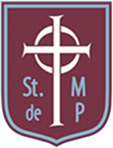Art & Design and Design Technology
Intent
At St Martin de Porres Catholic Primary School, we follow Kapow Primary’s Art & Design and Design Technology schemes of work as a guide to our planning and resourcing. Kapow Primary’s scheme of work, aims to nurture pupils’ creativity, imagination and visual literacy, encouraging them to think like artists and designers. The intention is for pupils to develop the confidence to experiment, express ideas and communicate meaning through visual and tactile media.
The scheme promotes an appreciation of art as a powerful form of human expression, helping pupils to understand its role across different cultures, time periods and creative industries. It encourages children to value originality, take creative risks and reflect critically on their own work and that of others.
The scheme supports teachers in developing their subject knowledge and pedagogical confidence, enabling the delivery of rich, engaging and purposeful lessons. The curriculum is designed to be both inclusive and ambitious, ensuring all pupils are equipped to enjoy, create and respond to art in meaningful ways.
Implementation
Lesson Structure
Recap and recall
Each lesson begins with a short activity revisiting prior learning. This helps reinforce key knowledge, activate long-term memory and create connections between past and new learning. Recap and recall activities are varied to keep the start of the lesson engaging and fun while still supporting active recall.
Attention Grabber
A short, engaging activity designed to hook pupils into the new learning in the lesson. The activity could be a thought-provoking question, a quick investigation or an interactive discussion to spark curiosity and enthusiasm for the topic.
Lesson Objective
The core part of the lesson, where children engage in activities that develop their understanding of the learning objective. The main part of the lesson usually includes a mixture of teacher modelling, guided practice and independent or collaborative tasks tailored to support all learners.
Wrapping Up
Lessons finish with a final reflective activity that consolidates learning. Wrapping up activities could involve reviewing the success criteria, discussing key learning or applying knowledge in a different context to assess understanding and encourage deeper thinking.
Spiral Curriculum
The lesson planning adopts a spiral curriculum model; this is where key knowledge and skills are revisited and built on at a level appropriate to children’s development.
A spiral curriculum enables primary school teachers to introduce complex topics to young children in a way that is both accessible and engaging. This method builds a strong pedagogical foundation, which can be developed further as children progress through primary school.
Spiral curriculums help pupils to make connections between different concepts and apply their learning in different contexts; when they return to the concept each time, it is often in a different context. This helps to promote deeper understanding and transfer of learning.
Timetabling
Each half-term, children explore creativity and practical skills through two complementary subjects. In the first half-term, we focus on Art and Design, encouraging imaginative expression, visual communication, and experimentation with a range of media and techniques. In the second half-term, we transition to Design and Technology, where students apply problem-solving and technical skills to design and create functional products, learning about materials, processes, and innovation. Together, these subjects develop both artistic flair and practical design thinking. This continues throughout the year as shown in the document below.
Impact
Through our curriculum, learners develop creativity, confidence, and critical thinking skills. They learn to express ideas visually, experiment with materials and techniques, and appreciate the role of art in culture and society. By fostering imagination and problem-solving, the curriculum equips students with transferable skills that support personal growth and future learning across all subjects.
 St Martin de Porres
St Martin de Porres 


